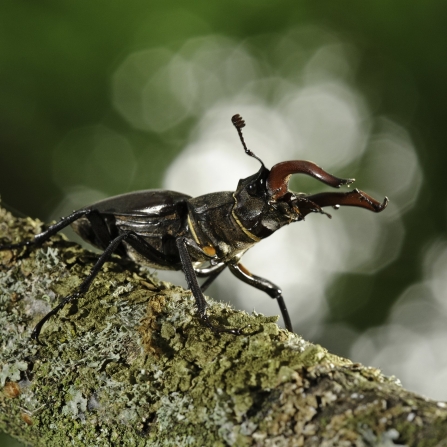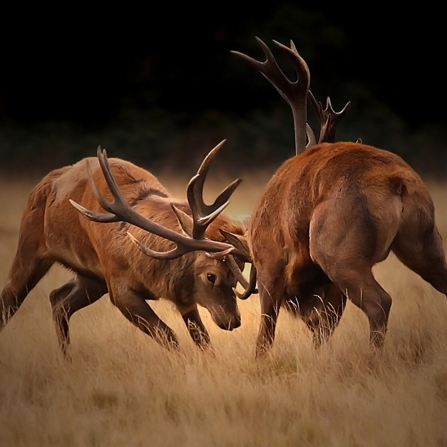Dwarves & Giants
(c) Amy Lewis

Goldcrest © Andy Morffew
...is the goldcrest. With only 6g - about as much as a sheet of paper - and a wingspan of 14cm, the goldcrest, together with its cousin, the firecrest, is truly our smallest bird. Despite their tiny size, they're often called 'king of the birds' due to the golden crest on their head resembling a crown. Their scientific name - regulus regulus - means king or knight.
The largest beetle...

Stag Beetle © Terry Whittaker/2020VISION
...is the stag beetle. This unmistakable beetle can grow up to 7.5cm and is found mostly in the South East of England. Famous for their fearsome jaws, they don't not have the bite to match. Just like stags, male stag beetles use their jaws to duel with rivals and display to females.
The largest bird...

White-tailed eagle © Amy Lewis
...in the UK is the white-tailed eagle with a wing span of up to 2.5m. Once widespread across the country, it has been hunted to extinction and today, the white-tailed eagle is very rare. In 2019, they were reintroduced to the Isle of Wight and have since been spotted flying over Hertfordshire occasionally, only recently during lockdown.
Probably the largest birds commonly found in Hertfordshire is the mute swan. Unimposing at first glance, wait until it spreads its wings: mute swans weigh up to 12kgs and have a wingspan of up to 240cm!
The smallest mammal...
Pygmy shrew © Peter Redfern
...is the pygmy shrew. Pygmy shrews are small rodents. Like many other small mammals, they have a very energetic metabolism - every day, they can consume one and a quarter of their body weight, which is only 3-5g. Pygmy shrews are widespread and can be found in grasslands, woodlands and hedgerows as well as wild areas in garden such as compost heaps.
The biggest land predator...

Badger (meles meles) - © Andrew Mason
...is the badger. Our beloved Brock is the largest land carnivore. It tips the scales at around 12-15kg and a shoulder height of around 30cm. It has a big appetite and is not picky about the menu: badgers are omnivores and eat anything from earthworms and other insects to fruits and cereals and even carrion.
The largest mammal...

Red deer © Jon Hawkins - Surrey Hills Photography
...is the red deer. The largest of the deer species and our largest mammal weighs in at up to 200kg - that's a mere 50,000 times the size of our smallest mammal. The males can easily establish eye contact with a full grown man - at a shoulder height of up to 140cm. You wouldn't want to get close enough, though, particularly in the rutting season in autumn when males establish their territory and fight over females. Their antlers grow to around 70cm and can be quite sharp.
It is, however, not our largest animal in the UK.
The largest animal in the UK...

Basking shark © Alexander Mustard/2020VISION
...is the basking shark. The world's second-largest fish can obviously not be found in Hertfordshire, but they are visiting British waters in summer, particularly the coast of Cornwall, the Isle of Man and the Inner Hebrides in Scotland. Basking sharks can grow up to 12m and weigh up to 6 tonnes, but don't worry, they are completely harmless! Like their relatives, whale sharks - the biggest fish - basking sharks only feed on zooplankton which they filter out of the water, swimming slowly back and forth with their enormous mouths wide open.

Wild At Home
We want to help everyone enjoy wildlife and connect with the wild places around them. Our #WildAtHome project aims to help bring you closer to wildlife in the safety of your home. Each week we'll be sending you ideas and inspiration on how to stay wild whilst remaining safe at home.

